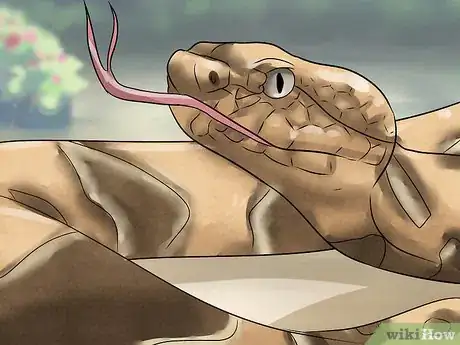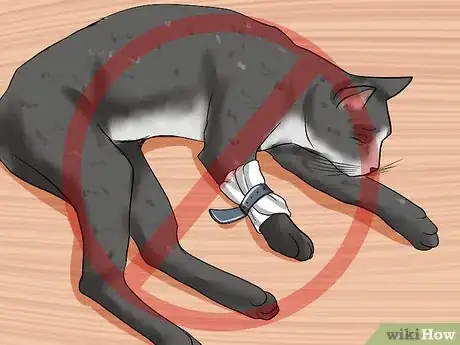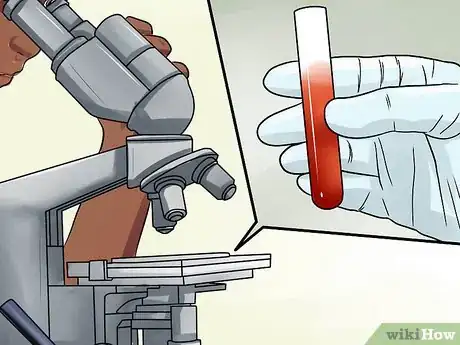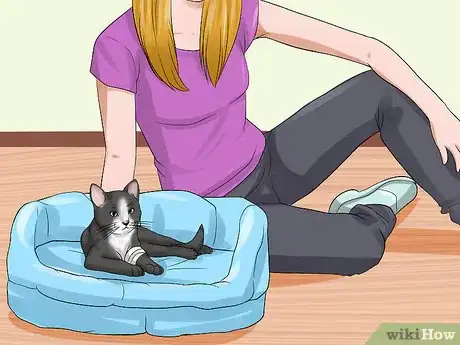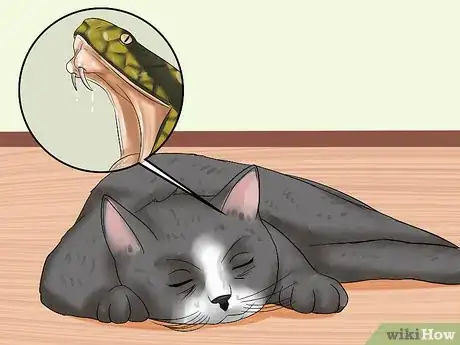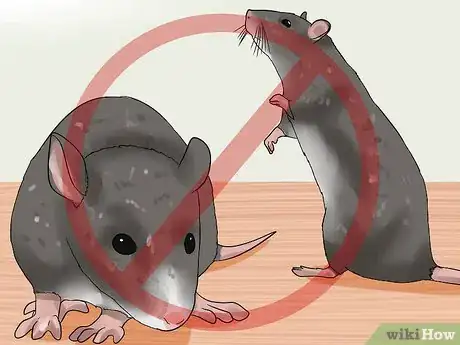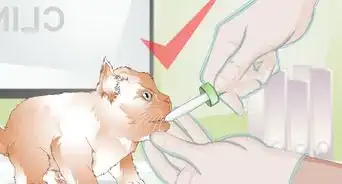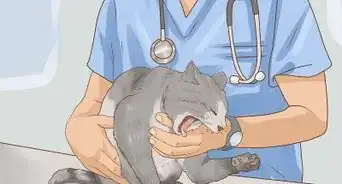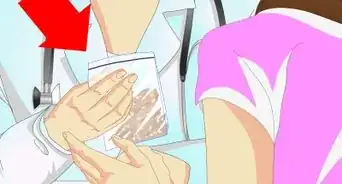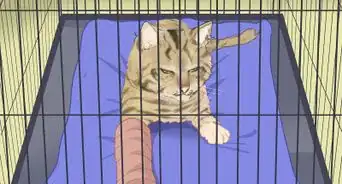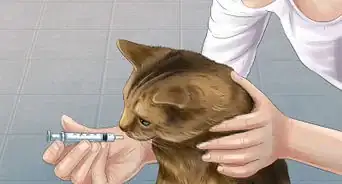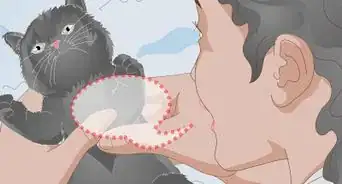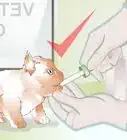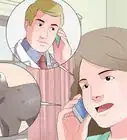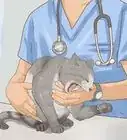This article was co-authored by Pippa Elliott, MRCVS. Dr. Elliott, BVMS, MRCVS is a veterinarian with over 30 years of experience in veterinary surgery and companion animal practice. She graduated from the University of Glasgow in 1987 with a degree in veterinary medicine and surgery. She has worked at the same animal clinic in her hometown for over 20 years.
There are 11 references cited in this article, which can be found at the bottom of the page.
wikiHow marks an article as reader-approved once it receives enough positive feedback. In this case, 84% of readers who voted found the article helpful, earning it our reader-approved status.
This article has been viewed 136,024 times.
While snakebites are relatively uncommon in cats, they can be very serious when they do happen. Because of your cat's small size, she could receive a relatively higher dose of the toxin contained within the snake’s venom. How your cat’s body responds to the snakebite will depend on several factors, such as the amount of venom injected, the bite site, and species of snake.[1] If your cat is bitten by a venomous snake, her chances of survival will increase if you can get her to your veterinarian immediately.
Steps
Assessing the Situation
-
1Examine the area of the snakebite. Most snakebites occur on either the muzzle or leg of a cat. If a venomous snake has bitten your cat, her skin may have one fang mark or several fang marks at the bite site.Unfortunately, these puncture marks may be obscured Because snake venom can negatively affect the blood’s ability to clot, there will likely be bleeding at the bite site as well.[2]
- The closer a venomous snakebite is to the heart, the more quickly the venom will be absorbed into the body and spread through the lymphatic and circulatory systems.[3]
- If your cat has been bitten by a nonvenomous snake, you will see teeth marks, but not fang marks, at the bite site. Also, there will probably little to no swelling, redness, or bleeding at the site where the snake bit your cat.[4]
-
2Pay attention to your cat’s clinical signs. After a venomous snakebite, your cat will become lethargic and may start vomiting. She will probably start to become very weak and collapse. In addition, her muscles may begin to twitch and her pupils will start to dilate. As more time passes after the snakebite, she could exhibit even more serious signs, such as seizures, paralysis, and shock.[5] [6]
- Signs of shock include rapid shallow breathing, hypothermia, and a rapid heart rate.[7]
- Because of the amount of pain she is in, she may also be more vocal.
- Do not wait to see if your cat shows symptoms of a snakebite. If you saw the snake bite your cat, or if you see the bite wound, take your cat to the veterinarian immediately.
- The onset of clinical signs after a snakebite is usually rapid—within a few minutes to an hour of being bitten. If your cat shows no clinical signs after 60 minutes, then the snake's venom likely did not enter her system.[8]
- Your cat may not exhibit these clinical signs if she has been bitten by a nonvenomous snake. However, you should still take her to your veterinarian for treatment and monitoring.
Advertisement -
3Try to identify the species of snake that bit your cat. In order to give the appropriate antivenin, it would be helpful for your veterinarian to know the species of the attacking snake. In the US, the most common venomous snakes are rattlesnakes, water moccasins, copperheads, and coral snakes.[9]
- If you witnessed the attack, stay calm and take note of the color, length, and pattern of the snake. For your safety, do not approach the snake to get a closer look.
- Do not try to kill the snake. You will put yourself in more danger of being bitten by approaching the snake and trying to kill it.
- Venomous snakes have slit-like pupils (similar to a cat), whereas non-venomous snakes have round pupils (like people).[10] There are exceptions, however. For instance, the venomous coral snake has round pupils.
- If you are not able to identify the snake or do not know if it is venomous, assume that it is venomous.
- The negative effects on the cardiovascular system can cause your cat to go into shock.
Taking Your Cat to Your Veterinarian
-
1Keep your cat calm and quiet. For a snakebite from a venomous snake, keeping your cat calm and quiet is the best first aid that you can administer to your cat before she receives veterinary care. The more agitated and active she is, the more quickly the venom could spread through her body and make her even sicker.[11] It is actually recommended that keeping your cat calm and quiet is the only first aid that you should administer on your own.[12]
- Do not allow your cat to walk or run around as this will increase her heart rate and stimulate more blood circulation.
- Keep in mind that your cat may snap at you or try to bite you because of the amount of pain that she’s in.
-
2Do not administer first aid other than gentle pressure. Gentle pressure will help control the bleeding from the bite wound. An example of first aid that you should not administer is cutting the wound open to suck out the venom or drain the wound.[13] Not only is this ineffective, you would cause more pain and suffering for your cat. In addition, the venom could be venomous to you.
- Do not apply a tourniquet or compression bandage in the area near the bite wound.
- Do not apply ice to the bite wound. The ice does not slow the spread of the venom and can actually damage the skin.
- Do not wash the wound if the bite was from a venomous snake. Washing the wound could increase the absorption of the venom.
-
3Take your cat to your veterinarian immediately. The action most likely to save your cat's life is getting her to your veterinarian as soon as possible. If possible, transport your cat in her carrier or a large box in which she can comfortably lie down. To help keep her calm and still during the drive to the veterinarian, loosely wrap your cat in a large towel or sheet.
- The effects of snake venom are usually irreversible and often begin immediately after the snakebite.[14] To increase the chances of your cat’s survival and treat the effects of the snake venom, your cat will need immediate veterinary treatment.
-
4Provide as much history as you can about the snakebite. Your veterinarian may have a snakebite detection kit, which would allow him or her to identify what type of snake bit your cat.[15] However, in the event that your veterinarian does not have the kit, you will need to provide as much information as you can about the snake bite, such as a description of the snake, how much time has passed since the snakebite, and what clinical signs your cat started to show after being bitten.
-
5Allow your veterinarian to diagnose your cat. Although clinical signs and the appearance of the snakebite may seem like enough to start treatment, your veterinarian will want to run diagnostic tests to fully assess the severity of the snakebite. For example, your veterinarian will run blood tests to see how well (or poorly) your cat’s blood is clotting. He or she may also take a urine sample (snakebites can lead to blood being in the urine).
- Depending on how well-equipped the veterinary clinic is, your veterinarian may want to perform an electrocardiogram to assess your cat’s heart beat.
-
6Approve of your veterinarian’s recommended treatment plan. Because of how quickly snake venom can spread and cause damage in your cat’s body, your veterinarian may want to begin some forms of treatment immediately to stabilize your cat. Do not be surprised if your veterinarian needs to start treatment to stabilize your cat before he or she gets a more detailed history from you. One form of immediate treatment is intravenous fluids, which will bring your cat’s blood pressure back up (very important if your cat has gone into shock).[16]
- Antivenin works by neutralizing the snake’s venom and is most effective when administered within the first six hours of a snakebite.[17] It can help to prevent bleeding disorders and reduce the amount of swelling at the bite wound. Keep in mind that antivenin is not a vaccination and will not protect your cat from future snakebites.
- Your veterinarian will likely administer a steroid, which will minimize further tissue damage, control shock, and prevent a possible allergic reaction from antivenin administration. Steroids are usually given only in the first 24 hours after a snakebite.[18]
- Your cat may also need oxygen supplementation and additional breathing support, depending on her level of respiratory distress when you get her to your veterinarian.[19]
- If your cat is suffering from serious blood circulation problems (little to no clotting, low blood cell counts), she will need to be treated with blood replacement products and other appropriate treatments.[20]
- Antibiotics are usually not necessary, since wounds from snakebites rarely become infected.[21]
-
7Ask your veterinarian about your cat’s prognosis. The prognosis for your cat varies depending on how much venom was injected, the species of snake, and how time has passed since the snakebite happened. Fortunately, nearly 80% of pets will survive snakebites if they receive immediate veterinary treatment.[22] Provided that your cat has a good prognosis, she will likely recover in 24 to 48 hours. This recovery may take longer (at least several days) depending on the extent of tissue damage.[23]
- Your veterinarian may recommend that your cat stay at the hospital overnight for an observation. She would need stay overnight if she needs continued intensive treatment. Once your veterinarian is confident that your cat has recovered well from the snakebite, he or she will send her home with you.
-
8Care for your cat when is released from the veterinary hospital. When your cat is well enough to come home, you will need to be responsible for her at-home care. Your veterinarian will probably prescribe a pain medication to control the pain from the snakebite. Your cat may need additional medications, depending on her clinical signs and results of the diagnostic tests.
Preventing Snakebites
-
1Learn how snake venom will affect your cat. Snakes use their venom most frequently to catch their prey. Keep in mind, however, that a snake would much rather flee than fight/bite if it encounters a human or a pet. If your cat has been bitten by a snake, the snake likely bit her in self-defense rather than as a predatory attack.
- Snakes have control over whether they inject venom with their bite. If they do not inject venom, the bite is known as a ‘dry bite.’ They may not inject venom if they have recently made a kill and used up their venom.
- Snakes can also control how much venom they inject when biting. For example, a smaller snake who fears for its life may inject more venom than a larger snake whose life is not in danger.
- Snake venom spreads rapidly via the lymphatic system and circulatory systems in the body and can eventually have a profound effect on all body systems. Typically, the venom targets the nervous and circulatory systems.[24] [25]
-
2Remove any potential hiding spots for snakes. Snakes like to hide in long grass, overgrown foliage, and under piles of wood.[26] [27] They also like to hide under rocks and logs. If your cat is indoor/outdoor or exclusively outdoor, clearing away any potential snake hiding spots will lessen the chance that your cat will come into contact with a snake.
- You can also keep your cat inside.[28]
-
3Purchase snake repellant. You can spray snake repellant in your yard to keep snakes away. Visit your local pet store for recommendations on which snake repellant to purchase. You could also purchase snake repellant online.
-
4Get rid of a snake’s food source. Rodents are a food source for snakes. Snakes may be attracted to your home if you have a rodent problem.[29] You can place rodent traps in and around your home. Alternatively, you could hire a pest control service to clear the rodents from your home.
Expert Q&A
-
QuestionHow can you tell if your cat has been bitten by a snake?
 Pippa Elliott, MRCVSDr. Elliott, BVMS, MRCVS is a veterinarian with over 30 years of experience in veterinary surgery and companion animal practice. She graduated from the University of Glasgow in 1987 with a degree in veterinary medicine and surgery. She has worked at the same animal clinic in her hometown for over 20 years.
Pippa Elliott, MRCVSDr. Elliott, BVMS, MRCVS is a veterinarian with over 30 years of experience in veterinary surgery and companion animal practice. She graduated from the University of Glasgow in 1987 with a degree in veterinary medicine and surgery. She has worked at the same animal clinic in her hometown for over 20 years.
Veterinarian Snake bites are painful so you can expect the cat to be distressed. Observe the cat to see where she is in pain. If she was bitten on a leg, then she will limp on that leg. Then carefully part the fur to see if there are a pair of puncture marks. There may be some ooze or bleeding from the wounds. In addition, the surrounding skin may look angry, reddened, or swollen. If in any doubt, take the cat to the vet immediately.
Snake bites are painful so you can expect the cat to be distressed. Observe the cat to see where she is in pain. If she was bitten on a leg, then she will limp on that leg. Then carefully part the fur to see if there are a pair of puncture marks. There may be some ooze or bleeding from the wounds. In addition, the surrounding skin may look angry, reddened, or swollen. If in any doubt, take the cat to the vet immediately. -
QuestionHow long does it take for a cat to recover from a snake bite?
 Pippa Elliott, MRCVSDr. Elliott, BVMS, MRCVS is a veterinarian with over 30 years of experience in veterinary surgery and companion animal practice. She graduated from the University of Glasgow in 1987 with a degree in veterinary medicine and surgery. She has worked at the same animal clinic in her hometown for over 20 years.
Pippa Elliott, MRCVSDr. Elliott, BVMS, MRCVS is a veterinarian with over 30 years of experience in veterinary surgery and companion animal practice. She graduated from the University of Glasgow in 1987 with a degree in veterinary medicine and surgery. She has worked at the same animal clinic in her hometown for over 20 years.
Veterinarian There is no easy answer, since it depends on the type of snake and how much venom was injected. In the worst case, a snake bite could be fatal in less than an hour, while for the cat that is bitten but recovers, it may have tissue damage where it was bitten which causes skin to slough and fall off, and could take weeks to recover from.
There is no easy answer, since it depends on the type of snake and how much venom was injected. In the worst case, a snake bite could be fatal in less than an hour, while for the cat that is bitten but recovers, it may have tissue damage where it was bitten which causes skin to slough and fall off, and could take weeks to recover from. -
QuestionCan a cat get a snake bite?
 Pippa Elliott, MRCVSDr. Elliott, BVMS, MRCVS is a veterinarian with over 30 years of experience in veterinary surgery and companion animal practice. She graduated from the University of Glasgow in 1987 with a degree in veterinary medicine and surgery. She has worked at the same animal clinic in her hometown for over 20 years.
Pippa Elliott, MRCVSDr. Elliott, BVMS, MRCVS is a veterinarian with over 30 years of experience in veterinary surgery and companion animal practice. She graduated from the University of Glasgow in 1987 with a degree in veterinary medicine and surgery. She has worked at the same animal clinic in her hometown for over 20 years.
Veterinarian Absolutely. A cat that disturbs a snake is every bit as likely to get bitten as people or dogs. Unfortunately, a young, playful cat may even regard a wriggly snake as something good to pounce on, with disastrous consequences.
Absolutely. A cat that disturbs a snake is every bit as likely to get bitten as people or dogs. Unfortunately, a young, playful cat may even regard a wriggly snake as something good to pounce on, with disastrous consequences.
Warnings
- Do not approach a dead snake. For as long as one hour after death, when touched they have a reflex action to grasp on and bite.⧼thumbs_response⧽
- Due to their close proximity to the heart, bites on the abdomen or chest carry a poorer prognosis than bites to the head or extremities.[31]⧼thumbs_response⧽
References
- ↑ http://www.vetwest.com.au/pet-library/snake-bite-and-your-pet
- ↑ https://www.vetinfo.com/treating-cat-snake-bite.html
- ↑ http://www.vetwest.com.au/pet-library/snake-bite-and-your-pet
- ↑ https://www.vetinfo.com/treating-cat-snake-bite.html
- ↑ https://www.vetinfo.com/treating-cat-snake-bite.html
- ↑ http://www.vetwest.com.au/pet-library/snake-bite-and-your-pet
- ↑ http://www.petmd.com/cat/emergency/accidents-injuries/e_ct_shock
- ↑ Veterinary Emergency Medicine Secrets: Rattlesnake Envenomation. Hackett & Winfield. Hanley and Belfus.
- ↑ http://www.merckvetmanual.com/mvm/toxicology/snakebite/overview_of_snakebite.html
- ↑ The Illustrated Guide to Venomous Snakes. US Dept of the Army. Lyons Press.
- ↑ https://www.vetinfo.com/treating-cat-snake-bite.html
- ↑ http://www.merckvetmanual.com/mvm/toxicology/snakebite/overview_of_snakebite.html
- ↑ http://www.cathealth.com/safety/cat-first-aid
- ↑ http://www.merckvetmanual.com/mvm/toxicology/snakebite/overview_of_snakebite.html
- ↑ http://www.vetwest.com.au/pet-library/snake-bite-and-your-pet
- ↑ http://www.pethealthnetwork.com/dog-health/dog-toxins-poisons/your-pet-venomous-snakes-part-ii
- ↑ http://www.merckvetmanual.com/mvm/toxicology/snakebite/overview_of_snakebite.html
- ↑ http://www.merckvetmanual.com/mvm/toxicology/snakebite/overview_of_snakebite.html
- ↑ http://www.vetwest.com.au/pet-library/snake-bite-and-your-pet
- ↑ http://www.merckvetmanual.com/mvm/toxicology/snakebite/overview_of_snakebite.html
- ↑ http://www.merckvetmanual.com/mvm/toxicology/snakebite/overview_of_snakebite.html
- ↑ http://www.vetwest.com.au/pet-library/snake-bite-and-your-pet
- ↑ http://www.vetwest.com.au/pet-library/snake-bite-and-your-pet
- ↑ http://www.snakesandspiders.com/understanding-snake-venom-works/
- ↑ http://www.merckvetmanual.com/mvm/toxicology/snakebite/overview_of_snakebite.html
- ↑ http://www.pethealthnetwork.com/dog-health/dog-toxins-poisons/your-pet-venomous-snakes-part-ii
- ↑ http://www.vetwest.com.au/pet-library/snake-bite-and-your-pet
- ↑ http://www.pethealthnetwork.com/dog-health/dog-toxins-poisons/your-pet-venomous-snakes-part-ii/page/0/1
- ↑ http://www.pethealthnetwork.com/dog-health/dog-toxins-poisons/your-pet-venomous-snakes-part-ii
- ↑ https://www.vetinfo.com/treating-cat-snake-bite.html
- ↑ http://www.merckvetmanual.com/mvm/toxicology/snakebite/overview_of_snakebite.html
About This Article
To treat a cat for a snakebite, take it to a vet immediately, since the dangerous effects of venom occur within minutes of the bite. If you witnessed the attack, take note of the color, length, and eye shape of the snake so you can report this to the vet. Then, try to keep your cat calm and still, since the more agitated and active it is, the more quickly the venom can spread through its body. Additionally, avoid administering any first aid, like cleaning the wound, which can cause more pain and suffering for your cat. For more tips from our Veterinary co-author, like how to spot the signs of a snake bite on your cat, read on!

